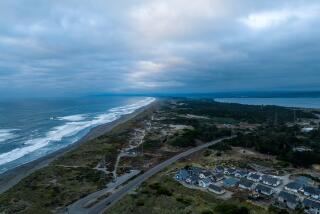Prices and Volume Up in Valley Areas
- Share via
More sales. Higher prices.
That about sums up the real estate action in the San Fernando and Santa Clarita valleys for the third quarter, which outperformed third-quarter activity last year by most measures.
A total of 3,725 single-family homes sold in the San Fernando Valley during the quarter ended Sept. 30, compared with 3,619 for the third quarter of 1998, according to statistics from the Southland Regional Assn. of Realtors.
In September, the last month of the quarter, the median single-family home price stood at $225,000--up from $189,900 in September 1998.
The median price for existing condos was $120,000 in September, just $2,000 above the 1998 mark, but sales rose more dramatically. In the third quarter, 1,135 condo sales closed, compared with 904 for the like quarter of 1998.
This year’s solid third-quarter performance didn’t surprise those who sell homes because they’ve been watching the market improve steadily since the end of the recession--and because July and August are traditionally two of the best home-selling months of the year, said Beth Sommer, president of the Southland Regional Assn. of Realtors.
Sales totals this year topped those from 1998 for two out of three months during the quarter, while the median prices for single-family homes and condominiums climbed every month on a year-to-year basis.
“I don’t think we can keep going at the same rate of increase, but we don’t see any reason to expect a downturn either,” Sommer said, meaning sales and prices might level off a bit but aren’t expected to decline.
Rising sales and prices reflect the healthy Southern California economy that continues to drive demand for housing while relatively few new homes are being built, according to Bob Bray, an analyst with the Meyers Group, a real estate consulting firm.
Meyers Group figures show the Santa Clarita Valley as the clear leader in new home sales, with 324 sales during the third quarter this year, compared with 81 new home sales in the San Fernando Valley. New home sales were up from 261 in the third quarter last year in the Santa Clarita Valley, but they dipped from 156 in the San Fernando Valley in last year’s third quarter.
“The story behind the numbers is the shift in development activity from the San Fernando Valley to the Santa Clarita Valley this decade. It shows that the market is very healthy and the supply is very tight in both valleys,” Bray said.
With little land left for development in the San Fernando Valley, Bray and Sommer both said, the two valleys have taken on distinct roles: The San Fernando Valley is primarily a market of existing home sales, while Santa Clarita will remain a leader in new home sales as long as it has land to develop.
But even where there is land to develop, Bray pointed out, rising new home prices in the Santa Clarita Valley indicate how tight the supply-demand relationship is.
“If you look at the way median prices continue to climb, it shows that home builders can raise prices. The reason they can raise prices is that there’s only a 10-week supply of inventory, which means that if builders stopped building, the supply we have would be exhausted in 10 weeks,” Bray said.
On the other hand, Bray noted, San Fernando Valley new home statistics can be misleading. The median price for a new home dropped to $186,950 in the San Fernando Valley in the third quarter this year, compared with $379,900 last year. Rather than a decline in values, Bray said, the drop simply means that the few new homes being built this year were “infill” projects in less expensive parts of the Valley.
“When you have so few new homes being built, just one project can affect the whole market,” he explained.
The low median price for new homes during the third quarter in the San Fernando Valley belies one trend that has marked the Valley in recent years: million-dollar tract homes at developments like Mulholland Park in Tarzana, overlooking Braemar Country Club, Mountain View Estates in Calabasas and other projects that command prices pushing the million-dollar mark.
Among the tracts to open during the third quarter was the Renaissance development of Shapell Industries at Porter Ranch. The homes will sell for up to $749,000 and are part of a community that will ultimately include 3,395 residences and 6 million square feet of stores, office buildings and other types of commercial development, according to plans approved by the Los Angeles City Council. Four of the Renaissance homes have sold since the project opened in early August, according to the Meyers Group.
The demand for housing also appears to finally be pushing development back out to the Antelope Valley. In August, Newhall Land & Farming Co. announced that it had entered a joint venture with Kaufman & Broad Home Corp. to build a long-delayed 5,000-home development on the western edge of Palmdale.
Kaufman & Broad gained regulatory approvals in 1993 for the 1,900-acre development called City Ranch, but the project stalled when the recession hit. Newhall officials said they expect to begin construction early next year and finish the first City Ranch homes late in the year.
In contrast to the Antelope Valley, the mature Glendale and Burbank residential market is one dominated by resales. Agents there report a strong third quarter.
“There’s not a lot for sale. When something good comes on the market it sells immediately, so we’re not building much of an inventory,” said Craig Farestveit, president of the Glendale Assn. of Realtors.
Many homes draw multiple offers, Farestveit said, noting that many buyers are entertainment industry workers who want to live near their jobs.
“It seems that if there are competitive offers on a property, at least one of them is from an animator,” Farestveit said.
Another characteristic of the Glendale market is that buyers are looking for older homes, he added.
“Glendale is a resale market anyway, but what’s most in demand is ‘30s and ‘40s architecture that’s been maintained and upgraded,” Farestveit said. “When the area was first developed, it was done in a way that you might find a bungalow-style home, a Mediterranean style, Spanish architecture and something else all on the same block. A lot of the buyers today like having a house that’s distinctive.”
Both Farestveit and Wayne Schulze, president of the Burbank Assn. of Realtors, said their markets capitalize on the older, established nature of their communities. Buyers consider it a plus that the cities are separate from Los Angeles and have their own police, fire and school systems, the real estate agents said.
“Good property [in Burbank] is hot. Anybody who wants to sell their property at market price will sell it in a very short time,” Schulze said.
With little land for new homes, Schulze said, Burbank relies on resales by homeowners moving to another part of the country or retiring.
The Valley’s active housing market mirrors a national trend in which record levels of home sales are virtually assured for 1999, according to a recent report from the National Assn. of Realtors.
The national organization said low unemployment, high consumer confidence, low mortgage rates and the stock market’s performance have all helped to improve the housing market. The group forecasts home sales to total 5.20 million this year nationally, which will be a 4.8% increase over the record 4.96 million sales in 1999.
Home and Condo Resales
* Residential Market: Home and condo prices in the San Fernando Valley were higher for each month of the quarter compared with the same period last year.
*
Source: Southland Regional Assn. of Realtors
More to Read
Inside the business of entertainment
The Wide Shot brings you news, analysis and insights on everything from streaming wars to production — and what it all means for the future.
You may occasionally receive promotional content from the Los Angeles Times.










